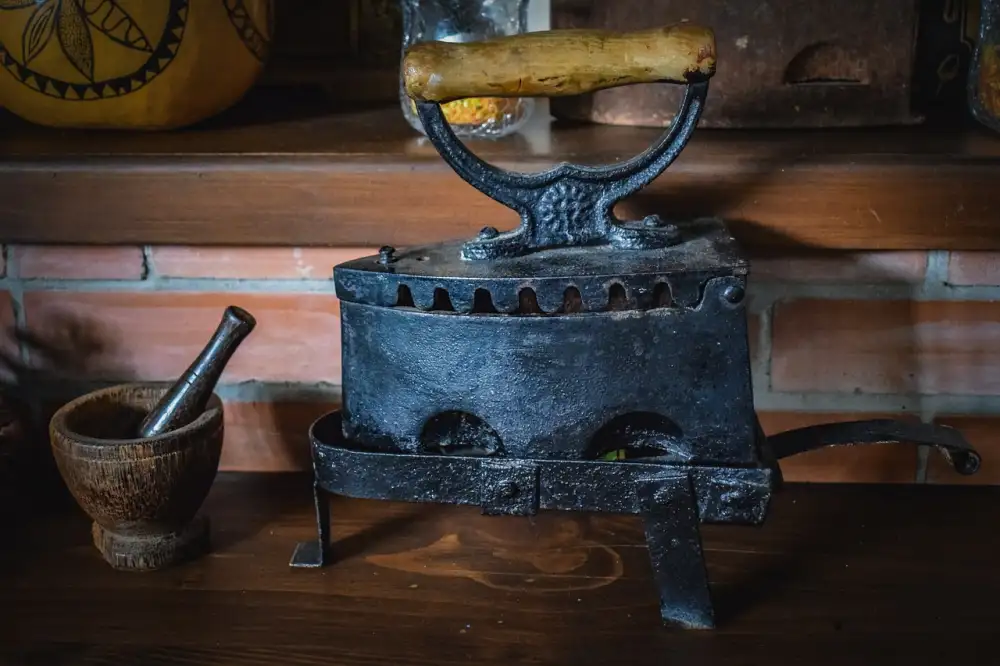Unlock the Charm of Antique Mortar and Pestle: Elevate Your Home Cooking Experience

- History and significance of antique mortar and pestle
- Types of antique mortar and pestle
- Benefits of using an antique mortar and pestle
- How to choose and care for an antique mortar and pestle
- Tips for using an antique mortar and pestle effectively
- Recipes that can be prepared using an antique mortar and pestle
The antique mortar and pestle is a timeless kitchen tool that has been used for centuries to grind, crush, and mix ingredients. This traditional culinary instrument consists of a heavy bowl-shaped mortar and a club-shaped pestle, both typically made of stone or marble. The mortar serves as the grinding surface, while the pestle is used to crush and pulverize ingredients.
This ancient tool has stood the test of time due to its simplicity and effectiveness in food preparation. While modern appliances have taken over many aspects of cooking, the charm and functionality of an antique mortar and pestle remain unparalleled. It not only adds a touch of nostalgia to your kitchen but also enhances your cooking experience by allowing you to create restaurant-quality dishes at home.
In this article, we will delve into the history and significance of antique mortar and pestle, explore different types available, discuss their benefits, provide tips on choosing and caring for one, offer suggestions for effective usage, and even share some delicious recipes that can be prepared using this classic kitchen tool. So let's unlock the charm of the antique mortar and pestle together!
History and significance of antique mortar and pestle
The history of the antique mortar and pestle dates back thousands of years, making it one of the oldest culinary tools still in use today. Ancient civilizations such as the Egyptians, Greeks, and Romans utilized this versatile tool for grinding herbs, spices, and grains. The significance of the mortar and pestle lies in its ability to release essential oils and flavors from ingredients, resulting in enhanced taste and aroma in dishes. This timeless tool has stood the test of time and continues to be cherished by chefs and home cooks alike for its effectiveness in creating authentic flavors.
Types of antique mortar and pestle
Antique mortar and pestles come in various materials, each with its own unique charm and functionality. The most common types include:
1. Stone: Stone mortar and pestles are the oldest and most traditional type. They are typically made from granite, marble, or volcanic rock. Stone mortars are known for their durability and ability to withstand heavy pounding. They also retain heat well, making them ideal for grinding spices.
2. Wood: Wooden mortar and pestles have a rustic appeal and are popular in many cultures. They are often made from hardwoods like olive wood or teak. Wood mortars are gentle on delicate ingredients like herbs, as they do not generate as much heat or friction during grinding.
3. Brass: Brass mortar and pestles add a touch of elegance to any kitchen. They are durable and resistant to corrosion, making them suitable for both wet and dry ingredients. Brass mortars also have excellent heat conductivity, allowing for efficient grinding.
4. Ceramic: Ceramic mortar and pestles are prized for their aesthetic appeal. They come in a variety of colors and designs, adding a decorative element to your kitchen decor. Ceramic mortars are versatile and can be used for grinding spices, crushing garlic, or making pastes.
5. Glass: Glass mortar and pestles provide a clear view of the ingredients being ground, making them ideal for monitoring consistency or texture changes during the process. They are easy to clean but may be more fragile compared to other materials.
When choosing an antique mortar and pestle, consider the type of ingredients you will be grinding regularly, as different materials may be better suited for specific tasks. Additionally, ensure that the size is appropriate for your needs – larger ones work well for batches while smaller ones offer greater control.
Proper care is essential to maintain the integrity of your antique mortar and pestle regardless of the material it is made from. Avoid using harsh chemicals or abrasive cleaners, as they can damage the surface. Instead, wash with warm water and mild soap, and dry thoroughly after each use.
By understanding the different types of antique mortar and pestles available and how to care for them, you can choose the right one for your cooking needs and enjoy the charm of these timeless kitchen tools.
Benefits of using an antique mortar and pestle
Using an antique mortar and pestle in your home kitchen comes with a multitude of benefits. Firstly, it allows you to have complete control over the texture and consistency of your ingredients. By grinding them manually, you can achieve the perfect coarseness or fineness required for your recipes.
Secondly, using an antique mortar and pestle helps to release the natural oils and flavors of herbs and spices. This enhances the taste profile of your dishes, giving them a more robust and authentic flavor.
Furthermore, an antique mortar and pestle are made from durable materials such as stone or marble, which ensures their longevity. Unlike modern appliances, they do not require electricity or batteries, making them a sustainable choice for eco-conscious individuals.
In addition to their functional benefits, antique mortar and pestle also add a touch of elegance and nostalgia to your kitchen. Their vintage charm can elevate the aesthetics of your cooking space while serving as a conversation starter when guests visit.
Overall, using an antique mortar and pestle offers a unique culinary experience that cannot be replicated by modern gadgets. It allows you to connect with traditional cooking methods while enjoying the numerous advantages it brings to your home cooking endeavors.
How to choose and care for an antique mortar and pestle
When choosing an antique mortar and pestle, there are a few key factors to consider. Firstly, look for one made from a durable material such as granite or marble, as these will withstand heavy use and grinding without wearing down. Additionally, pay attention to the size and weight of the mortar and pestle – you want one that feels comfortable in your hands and is large enough to accommodate your ingredients.
To care for your antique mortar and pestle, it's important to clean it properly after each use. Avoid using soap or harsh chemicals, as they can damage the material. Instead, rinse it with warm water and scrub gently with a brush or sponge. Allow it to air dry completely before storing.
To prevent staining or absorbing flavors from previous uses, some experts recommend "seasoning" your mortar and pestle. This involves grinding uncooked white rice in the mortar until it becomes a fine powder. Discard the rice powder and repeat the process until no more residue appears on the rice powder.
Finally, store your antique mortar and pestle in a cool, dry place away from direct sunlight to prevent any potential damage or discoloration. With proper care, an antique mortar and pestle can become a cherished kitchen tool that lasts for generations.
Tips for using an antique mortar and pestle effectively
1. Start with a clean surface: Before using your antique mortar and pestle, make sure it is thoroughly cleaned and dried to prevent any unwanted flavors or contaminants from affecting your ingredients.
2. Choose the right size: Consider the size of your antique mortar and pestle when selecting ingredients. Larger mortars are better suited for grinding spices or making pastes, while smaller ones are ideal for crushing herbs or garlic.
3. Use gentle pressure: Unlike modern appliances, an antique mortar and pestle require a bit more effort. Apply gentle pressure while grinding to avoid damaging the mortar or releasing excessive heat that may alter the flavor of your ingredients.
4. Grind in batches: If you have a large quantity of ingredients to grind, it's best to do it in batches rather than overfilling the mortar. This ensures consistent results and prevents overcrowding.
5. Use circular motions: Instead of pounding straight up and down, use circular motions with the pestle to evenly grind your ingredients. This technique helps distribute the force more evenly, resulting in a finer texture.
6. Add ingredients gradually: When making pastes or sauces, add ingredients gradually to achieve the desired consistency. This allows you to control the texture and flavor better.
7. Experiment with different techniques: Don't be afraid to experiment with different grinding techniques such as crushing, pounding, or grinding in a figure-eight motion. Each method can yield unique results depending on the recipe.
8. Clean immediately after use: To maintain the integrity of your antique mortar and pestle, clean it promptly after each use. Avoid using harsh detergents or abrasive materials that could damage its surface.
By following these tips, you can ensure that your antique mortar and pestle remains functional and provides exceptional results in your culinary endeavors.
Recipes that can be prepared using an antique mortar and pestle
1. Pesto: The traditional method of making pesto involves grinding fresh basil leaves, garlic, pine nuts, Parmesan cheese, and olive oil in a mortar and pestle. This results in a rustic and flavorful sauce that pairs perfectly with pasta or as a spread on bread.
2. Guacamole: Using an antique mortar and pestle to mash ripe avocados, onions, garlic, cilantro, lime juice, and salt creates a chunky and authentic guacamole. The texture achieved by hand-grinding the ingredients enhances the overall taste experience.
3. Curry paste: Many Asian cuisines rely on homemade curry pastes for their rich flavors. By pounding together various spices such as coriander seeds, cumin seeds, turmeric root, ginger, garlic, and chili peppers in an antique mortar and pestle, you can create a fragrant and vibrant curry paste.
4. Salsa: For a truly authentic salsa experience, use an antique mortar and pestle to crush tomatoes, onions, jalapenos or other chili peppers, garlic cloves, cilantro leaves, lime juice, salt, and pepper. The resulting salsa will have a robust flavor with varying textures.
5. Aioli: Making aioli from scratch requires grinding garlic cloves with egg yolks in an antique mortar and pestle until smooth. Slowly incorporating olive oil while continuously grinding creates a creamy emulsion that is perfect for dipping fries or spreading on sandwiches.
6. Spice blends: Create your own unique spice blends by grinding whole spices like cumin seeds, fennel seeds, peppercorns or dried herbs in an antique mortar and pestle. This allows you to customize the intensity of flavors according to your preference.
Using an antique mortar and pestle not only adds authenticity to these recipes but also allows you to control the texture of the final product. The process of grinding ingredients by hand releases their essential oils, intensifying the flavors and aromas. So, embrace the charm and functionality of an antique mortar and pestle in your kitchen to elevate your culinary creations.
In conclusion, incorporating an antique mortar and pestle into your kitchen not only adds a touch of nostalgia but also enhances your cooking experience. The rich history and significance of these culinary tools make them more than just decorative pieces.
By using an antique mortar and pestle, you can unlock the true flavors and aromas of your ingredients. The grinding action releases essential oils, resulting in a more intense and complex taste profile. Additionally, the coarse texture achieved with a mortar and pestle adds depth to sauces, dressings, and marinades.
When choosing an antique mortar and pestle, opt for one made from durable materials such as granite or marble. These materials ensure longevity and efficient grinding. Proper care involves cleaning with warm water after each use and avoiding harsh detergents that may damage the surface.
To make the most out of your antique mortar and pestle, follow some tips for effective usage. Start by crushing ingredients in small batches to maintain control over consistency. Use a circular motion while grinding to evenly distribute pressure. And don't forget to experiment with different spices, herbs, nuts, or seeds to explore new flavors.
Lastly, consider trying out recipes specifically designed for the use of a mortar and pestle. From traditional dishes like guacamole or pesto to unique creations like homemade curry pastes or spice blends, there are endless possibilities to elevate your culinary skills.
So why not embrace the charm and functionality of an antique mortar and pestle in your own home? By doing so, you'll not only enhance your cooking but also connect with centuries-old traditions that have stood the test of time.
Published: 24. 02. 2024
Category: Home



